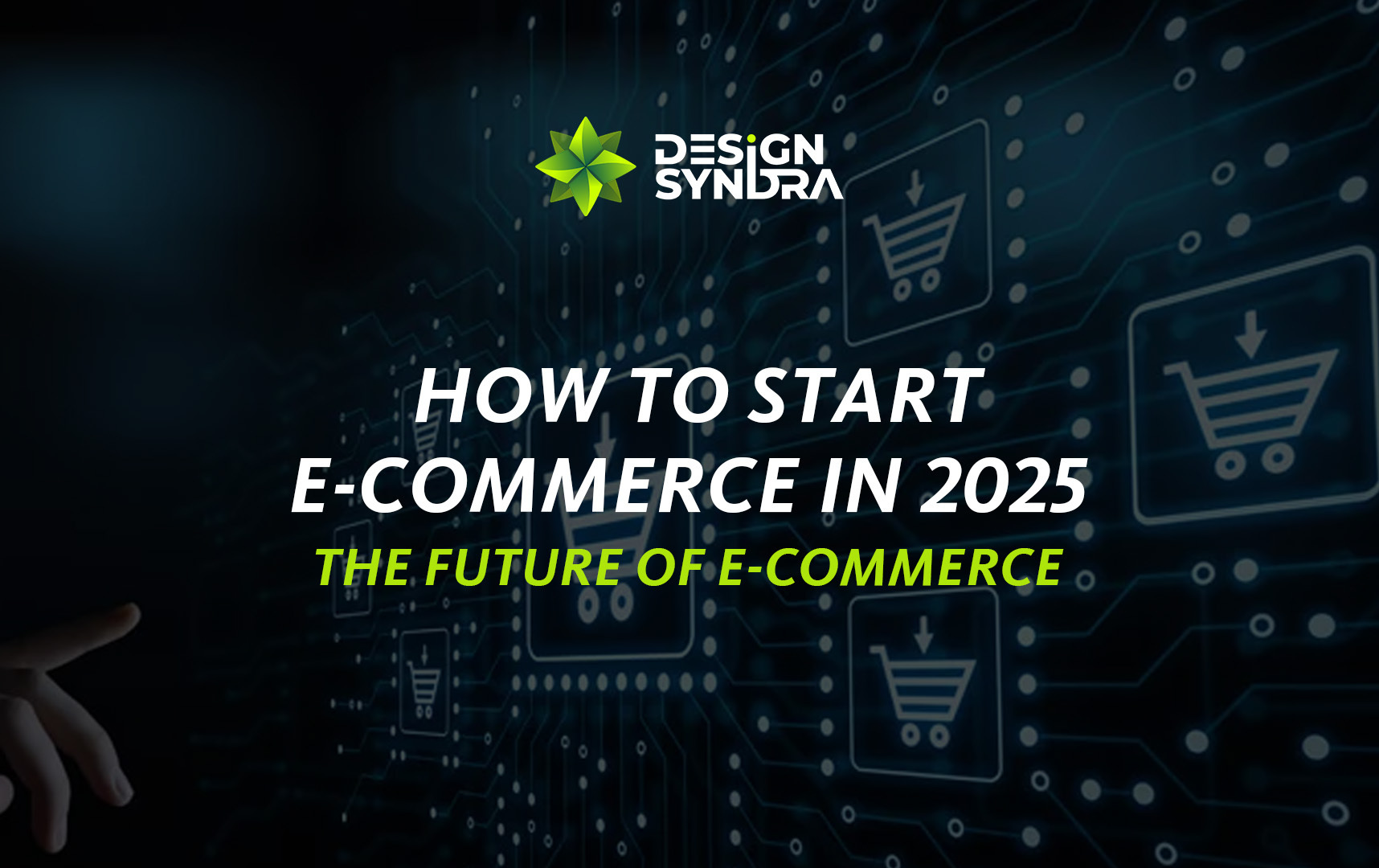Why Starting E-Commerce in 2025 Demands a Future-Forward Approach
The digital retail world is rapidly changing, and 2025 marks a pivotal moment for anyone looking to start an e-commerce business. It's no longer enough to simply list products online. Consumers expect more personalized, seamless, and meaningful shopping experiences driven by advanced technology and thoughtful strategy.
At Design Syndra, we understand that building an e-commerce business in today's digital age requires foresight, adaptability, and a deep understanding of emerging consumer behaviors. This comprehensive guide will walk you through the critical steps and trends you need to know to launch a thriving e-commerce store that's ready for the future.
Whether you're a first-time entrepreneur or a business expanding online, these strategies will help you build a foundation designed for long-term growth.
Understanding the 2025 E-Commerce Landscape
The Growth Trajectory and Consumer Behavior Shifts
The global e-commerce market is expected to surpass a staggering $7.4 trillion by the end of 2025. This explosive growth is fueled by technological innovation and changing consumer expectations worldwide.
What's driving this shift? Mobile commerce now dominates shopping traffic, accounting for nearly 75% of e-commerce visits, meaning brands must prioritize mobile optimization. Additionally, social media platforms have transformed from simple marketing tools into direct sales channels where users can shop instantly without leaving the app.
Consumers in 2025 want more than just products—they want brands that understand their needs, deliver value quickly, and align with their ethics. This means offering:
- Ultra-fast and reliable shipping options
- Personalized recommendations based on browsing behavior
- Ethical and sustainable product options
- A seamless blend of online and offline experiences
At Design Syndra, we help clients tap into these evolving preferences, turning trends into actionable strategies.
The Role of Emerging Technologies
E-commerce today integrates powerful technologies like artificial intelligence (AI), augmented reality (AR), and voice commerce to redefine shopping experiences.
AI helps brands analyze vast data to deliver personalized content and product recommendations, automating marketing and customer service in ways previously unimaginable.
Augmented reality enables shoppers to virtually try products, such as makeup or furniture, creating an immersive and confident buying journey.
Voice search is growing exponentially, changing how consumers find products by asking natural language questions like, "Where can I buy sustainable sneakers near me?"
Design Syndra stays at the forefront of these innovations, guiding clients to implement tools that not only attract but deeply engage customers.
Step 1 – Finding Your Perfect Market Focus Using Targeted Keyword Insights
The Power of Niche Selection in 2025
Success in e-commerce today begins with choosing the right niche. Rather than competing with giant retailers on broad categories, focusing on a specialized niche allows for targeted marketing, stronger brand identity, and better customer loyalty.
Niche markets solve specific problems or cater to unique interests—think eco-friendly kitchen gadgets, vegan skincare for sensitive skin, or customizable athletic apparel.
Conducting Research for Market Validation
Reflect highly specific buyer intent and often face less competition, making them gold mines for SEO.
For example, phrases like "best sustainable yoga mats for beginners 2025" or "affordable custom engraved jewelry for anniversaries" indicate clear purchase intent. Incorporating these keywords into your product descriptions, blogs, and metadata attracts qualified traffic and improves conversion rates.
At Design Syndra, we perform detailed keyword audits that help validate your niche's potential and identify untapped opportunities to rank organically on search engines.
Step 2 – Choosing the Right E-Commerce Platform
Comparing Popular Platforms for 2025
With a wide range of e-commerce platforms available, selecting the right one is crucial. Each comes with its own set of features, costs, and scalability options.
- Shopify is ideal for beginners and mid-sized businesses thanks to its user-friendly interface, app ecosystem, and reliable hosting.
- WooCommerce, built on WordPress, offers flexibility and is perfect for businesses that want full control over customization.
- BigCommerce shines for growing brands needing strong native SEO tools and multi-channel selling.
- Magento suits enterprises that require complex customization and integrations but demands more technical knowledge.
Why a Mobile-First and Headless Architecture Matters
Mobile devices dominate, so your platform must deliver lightning-fast, responsive experiences optimized for small screens.
Headless architecture separates the front-end user interface from the back-end systems, giving you greater flexibility to innovate with new user experiences and faster site performance.
At Design Syndra, we help clients choose and implement platforms that balance usability, performance, and scalability, ensuring they're future-proof.
Step 3 – Designing a Seamless User Experience (UX)
Prioritizing Speed and Accessibility
Studies show that 53% of mobile users abandon sites that take longer than 3 seconds to load. A slow website kills conversions.
Your store should also be accessible—including for users with disabilities—to widen your audience and comply with legal standards.
Creating Intuitive Navigation and Checkout Flows
Clear menus, smart filtering, and a streamlined checkout process reduce friction and cart abandonment. Offer multiple payment methods and guest checkout options to simplify the buyer journey.
Design Syndra employs UX best practices supported by user testing and analytics to craft effortless shopping paths that delight customers and increase sales.
Step 4 – Leveraging AI and Automation Tools
AI-Powered Personalization Engines
Personalized experiences aren't optional anymore; they're expected. AI algorithms track browsing and purchase history to deliver tailored product suggestions and content.
Automating Marketing and Customer Service
Automated email campaigns triggered by behavior—like cart abandonment or repeat purchases—increase engagement. AI chatbots provide instant customer support 24/7, reducing costs while improving satisfaction.
Our team at Design Syndra integrates intelligent automation tools that scale with your business and personalize customer touchpoints effectively.
Step 5 – Building a Multi-Channel Sales and Marketing Strategy
Social Commerce and Influencer Marketing in 2025
Selling directly on platforms like Instagram, TikTok, and Facebook lets you meet consumers where they spend time. Interactive shoppable posts and live streams drive immediate conversions.
Partnering with micro-influencers boosts authenticity and community trust, leading to higher engagement and sales.
Optimizing for Voice and Visual Search
Consumers increasingly use voice assistants and image search to find products. Optimizing your content for these search types with conversational keywords and clear product visuals enhances discoverability.
Step 6 – Prioritizing Ethical Practices and Sustainability
Transparent Supply Chains and Eco-Friendly Packaging
Consumers care deeply about a brand's ethics. Showcasing sustainable sourcing, cruelty-free practices, and minimal packaging builds loyalty and brand advocacy.
Inclusive Marketing and Accessibility
Celebrate diversity in your marketing and ensure your website accommodates users of all abilities—this not only broadens your market but strengthens your brand's reputation.
Step 7 – Monitoring Performance with Advanced Analytics
Key Metrics to Track
Track conversion rate, bounce rate, average order value, customer lifetime value, and return on ad spend. These metrics provide insight into where to optimize your store and marketing.
Leveraging Predictive Analytics for Growth
Predictive analytics anticipate buying patterns and customer needs, allowing you to launch proactive campaigns that increase revenue and customer retention.
Design Syndra builds customized dashboards to turn complex data into clear, actionable business intelligence.
Future-Proofing Your E-Commerce Store
Preparing for AR/VR Integration
Augmented and virtual reality tech allows shoppers to "try before they buy" virtually—boosting confidence and reducing returns.
Exploring Blockchain for Transparency and Security
Blockchain technology offers immutable transaction records and enhances supply chain transparency, building consumer trust in your brand.
Conclusion: Launch Your 2025 E-Commerce Business with Confidence
Starting an e-commerce business in 2025 means embracing innovation, prioritizing customer experience, and aligning with evolving consumer values.
By carefully selecting a niche, choosing the right platform, designing intuitive user experiences, and integrating AI and automation, you position your brand for lasting success.
At Design Syndra, we partner with you every step of the way—bringing cutting-edge strategy and technology to your e-commerce journey.
Are you ready to turn your e-commerce vision into reality? Let Design Syndra guide you to success in 2025 and beyond.
FAQs About Starting E-Commerce in 2025
What is the best e-commerce platform to start with in 2025?
Shopify offers ease and scalability for most startups, but WooCommerce or BigCommerce provide flexibility for customized needs. The right choice depends on your goals.
How important is AI in modern e-commerce?
AI enhances customer personalization, automates support, and improves inventory management—essential for competitive edge.
What's the biggest challenge for new e-commerce businesses today?
Standing out in a saturated market requires focused niches, authentic branding, and superior UX.



